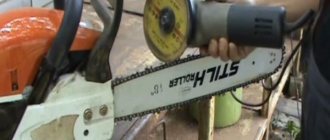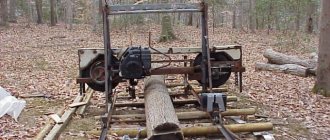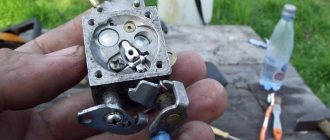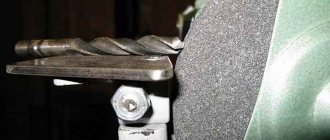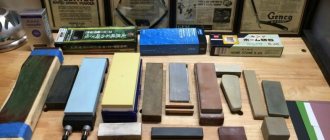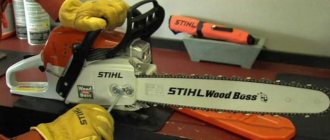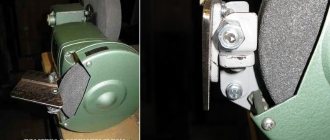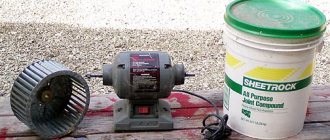Saw chains for rip sawing with a chainsaw
A modern chain for longitudinal sawing is represented by a rather complex design, which is made using high-quality steel, characterized by increased wear resistance and corrosion resistance. Among the features are the following:
- The design is represented by individual links that are connected to each other in a special way. This ensures a high level of flexibility; the rip sawing chain can follow the complex shape of the bar.
- There are several different plates for their purpose: cutting, guiding and connecting. Cutters directly remove material.
The natural process of operation becomes the reason why cutting inserts wear out. In addition, violation of operating recommendations can also lead to a similar result, for example, if soil gets into the cutting zone.
That is why all owners of such a tool should pay attention to exactly how sharpening is carried out.
External signs of a blunt cutting edge of a chainsaw tooth
Sharpening a chain for rip sawing is usually carried out exclusively when it is worn out; the procedure is rarely performed periodically. That is why you need to know exactly what signs indicate the need for such a procedure. Among the features of the issue under consideration, we note the following:
- The tooth of a chainsaw rip sawing chain is characterized by a complex configuration, so it will not be possible to determine defects simply by visual inspection.
- To check the condition of the teeth, test cutting is carried out. If vibration occurs when performing such work, this indicates the need for sharpening.
- The condition of the rip sawing chain can also be determined by visual inspection of the chips. Rough chips and dents also indicate a need for maintenance.
- The pressing force of the chainsaw is also taken into account when assessing the condition of the chain. At first, when sawing, the plates easily enter the material, but with severe wear, even at the beginning you have to apply force.
A visual inspection may also reveal rounded and tapered areas that indicate chain wear and other defects. However, such a sign can only be identified by a specialist with extensive experience.
Grinding angles and saw tooth configurations
As previously noted, the product in question is characterized by a rather complex configuration. Among the features of modern versions, the following points can be noted:
- The choice of chain for rip sawing is carried out for a specific chainsaw model, since the configuration largely depends on the power and some other points.
- For rip sawing, the cutting blade spacing is 0.325 inches. This ensures high stability during operation.
- The cutting edge can have a thickness of 1.3 mm. There are also versions on sale that have a thickness of about 1.1 mm, but they are difficult to sharpen at home. In addition, the small thickness allows cutting of thin branches.
- Attention is also paid to the profile height, which varies in the range from 0.625 to 0.762 mm. For domestic versions, the low profile version is suitable. This indicator determines the likelihood of vibration occurring at the time of sawing.
The sharpening angle of a chainsaw chain largely depends on the purpose of the tool, as some are suitable for cross-cutting, others for sawing. The longitudinal resistance of wood to sawing is very high, so the edges must be very sharp. The recommended sharpening angle is 6-12°. The difference in cutting angles is selected depending on the task at hand, as well as some other points.
When performing work, do not forget that too low a sharpening rate causes rapid grinding of the edge. This point is most important in the case when the product is manufactured using alloy steels, for example, grade 40ХГС.
Chain saw sharpening template
To significantly simplify the procedure, it is recommended to purchase a special template, which greatly simplifies the procedure for setting the required angle. Such a tool allows you to check the indicator of the rear angles of the conical and top blades, as well as the leading edge of the cutting edge.
Experts point out that the most important thing is to use a template to control the clearance angle. This is due to the difficulty of changing this indicator, and it must be maintained within a strict range.
A fairly common indicator is the grinding angle, which also varies depending on the task at hand.
Too high a material hardness determines the need to reduce this indicator. Experts indicate that the optimal value varies from 10 to 12°.
Mechanized sharpening on a machine
Special tools that can be used to simplify the procedure have become quite widespread. Such machines are equipped with a special electric drive and grinding wheels with increased wear resistance.
A small tool is suitable for use at home. Such devices can be powered from a 220 V network, and the power consumption is 100 W. Installing a chain is quite simple; the sharpening procedure can be carried out even without special training.
When choosing a machine, pay attention to the following points:
- Adjustment of the sharpening angle within a certain required range.
- Possibility of processing chains with different pitches and cutting edge thicknesses.
- Features of the procedure for changing grinding discs.
- Control of the cutting width value.
- Power of the installed electric motor and energy consumption indicator.
In addition, it is recommended to pay attention to the popularity of the brand, since service life and many other aspects depend on this.
In conclusion, we note that mistakes made at the time of sharpening can cause increased chain wear. That is why, if you use a tool frequently and do not have a sharpening machine required, it is recommended to entrust the work to professionals who provide the appropriate services.
If you find an error, please select a piece of text and press Ctrl+Enter.
A chainsaw is a necessary tool for household needs; it can find worthy use in the countryside. A chainsaw is easy to cut wood for a stove or fireplace. It also performs well when felling trees. Every owner of such an assistant should know the correct angle for sharpening chainsaw chains. Calling a specialist to your home, and especially to your dacha, costs a lot of money. Therefore, you have to make do on your own.
Read also: How to clean hardened polyurethane foam
Although it is better to entrust sharpening to a professional, some lumberjacks have learned this craft on their own. If wood cutting specialists have to sharpen a chain 3-4 times a day, then an ordinary gardener does not have such a need due to the fact that he rarely uses the tool. How can you master the craft yourself? There are some recommendations for this.
Features of the chainsaw
Cutting wood is similar to working with a plane. In this case, the size of the cut depends on the thickness of the limiter. When the saw chain works hard, the teeth become dull faster. This is clearly manifested when the ground surface appears in the path of the chain. To completely dull the teeth, it is enough to “catch” on the ground for a couple of seconds.
If you sharpen it as often as possible, the chain will last much longer, since very little metal will be removed. In addition to the question of what angle of sharpening the chainsaw chain should be, you should also know this!
Working with a dull tool is undesirable for a number of reasons. First of all, this affects the quality of the cut, and not for the better. Fatigue also quickly sets in, which is felt not only in the hands, but also in the body.
Another reason is unjustified excess fuel consumption. All parts will work in increased mode, which inevitably leads to rapid wear. Performance drops seriously, which also happens when using a defective chain.
How to choose a file for sharpening a chainsaw chain
Most users are wondering how to choose a file for sharpening a chainsaw chain. The answer to this is complicated, because... implies a lot of options. But the most correct way is to pay attention to the chain pitch. The size (diameter) of the cylindrical file depends on it. But in addition to it, a second one is also required - flat. Two files are used to sharpen different parts of one link. If we look at the process in more detail, a cylindrical file is used to sharpen the saw tooth of the link, namely the end and top blades. Use a flat file to file down the sawing depth limiter. It is important that both files can be purchased as a set with a set of templates and a hook for cleaning the saw and bar from the saw set. Some manufacturers of chainsaws and their electric chain analogues even produce similar kits themselves.
Features of the chain structure
To effectively be able to sharpen a chainsaw chain, you need to know the structure of its teeth. You can’t do without knowing the sharpening angle. Each tooth has a complex structure. Its geometry is represented by the following components:
- basis;
- spatula;
- depth limiter.
In this case, the blade consists of two blades: the end blade and the top blade. Moreover, between them there must be the correct sharpening angle of the chainsaw chain in order to provide it with the necessary performance.
As you can now guess, it is not the chain that cuts the tree, since it serves as the basis for securing the cutting links and moves them at high speed. The links themselves have sharp blades, with the help of which the wood is cut.
How and how to sharpen chain teeth
The saw chain teeth have an unusual shape. Sharpening a chainsaw chain is easy | country affairs. They consist of a base, a blade and a depth stop. At the same time, the spatula has a vertical blade and a horizontal blade that falls at an angle. It is thanks to these blades that the chainsaw cuts through wood.
Many people do not know how to sharpen the teeth on a chainsaw chain, but this is quite easy. round ratfil 4.8 mm and that’s it.
Many people don’t know how to sharpen the teeth on a chainsaw chain, but it’s quite simple. round file 4.8 mm and that’s it.
How do you know when sharpening is needed?
You can determine whether the chain teeth have been ground down or not by looking at some characteristic signs. Of course, it all depends on how intensively the chainsaw is used. It’s worth taking a closer look at what kind of shavings it leaves behind. Its uniformity and square shape indicate sharp teeth. If the chain is worn down, it usually leaves behind wood dust, and the sawdust itself resembles the needles that a hand saw “produces.”
If the cutting speed is reduced, then this is also considered a sign of a dull chain. You can feel an increase in the load on the instrument itself and the appearance of vibration. Beginners may not always be able to spot some of these signs. Therefore, they should pay more attention to the quality of the chips. Sometimes it can be brown, which is a guaranteed indication that it’s time to sharpen the chain.
Sharpening methods
To sharpen a tool, you can turn to the services of craftsmen who not only know what angle of sharpening chainsaw chains is necessary, but also do all the work quickly and at a professional level. As a rule, the cost of such services is not so high, but the quality, on the contrary, is very high! This option is suitable for those who like to cut wood and have no desire to tinker with their tools.
Everyone else will be interested in trying their hand at this. Professionals in this regard always choose automatic equipment, which is characterized by maximum efficiency and accuracy. Of course, not every lumberjack can afford to purchase it, and therefore they manage in different ways. And here, among many amateurs, there are discussions about which technique is better to give preference:
- manual;
- alternative;
- modern.
You should not neglect the signs of dullness, and at the first need, begin the operation of sharpening the chainsaw chain. This will allow you to use it for as long as possible.
Chain sharpening angle for Shtil chainsaw 180
For the Stihl MS 180, the chain is sharpened in the same way as for any other chain saw, there are no differences. For clarity, see the photo below, from an official representative of the company.
The photo shows what angle to keep in the horizontal plane, in the vertical, as well as the height position of the file.
Correct sharpening angle values
The sharpening angle of chainsaw chains is not a constant value and does not depend on the manufacturer or model of equipment. It is selected taking into account what kind of tree you will be dealing with. You can choose some average value, but the cutting efficiency may be ineffective. For this reason, it is necessary to choose the correct value, taking into account the specific type of wood.
If we are talking about solid wood, including those trees that have been “frozen” for a long time, it has a high resistivity. In this regard, the sharpening angle should be reduced. This will practically avoid the occurrence of vibrations, and the movement of the chain will be softer. The minimum value is 25°.
For soft types of wood, the sharpening angle can be increased, but not more than 35°. This will significantly improve productivity. As for the sharpening angle of the chainsaw chain for rip sawing, the value is 10°. In this case, the cut will be as smooth as possible, and equipment vibration will be minimized. Knowing these features, you can move on to considering different sharpening methods.
What is included in the sharpening kit?
In the absence of a special machine, you will have to make do with a file to sharpen the chainsaw chain (more precisely, not one, but two). You also need a special template with which you can check the current value of the sharpening angle. Thus, the basic set of sharpening equipment includes:
- Round file with a cross-sectional diameter of 4.5…5 mm.
- A holder with special positioning lines, with the help of which the tool can be placed on the top face with the required accuracy. The holder is equipped with a section that rests on the surface of the cutting depth limiter.
- A flat file used to sharpen the limiter itself.
- A hook that removes sawdust generated during the sharpening process.
It should be noted that manual sharpening is effective only when the signs of dullness of the chainsaw are established very quickly, and the wear is relatively small. Otherwise, more complex and expensive specialized machines will be required. Manual machines in the FUG size range are also suitable for working with Shtil-180 chainsaw teeth. Their advantage is that it is possible to qualitatively sharpen teeth whose wear turned out to be sharply uneven.
Experts advise purchasing sets of such files at the same time as purchasing the saw itself, or, in extreme cases, in the same store. Because there is no universal file for sharpening chainsaws from different manufacturers.
Manual method
This is the simplest and slowest method for sharpening chain teeth. However, the method is good when sharpening is done on site in the forest. Why not carry a whole machine with you all the time?! But here it’s worth being more precise - we don’t mean one tool, but a whole set, which includes:
- flat file;
- round file;
- sample.
Each of them performs their duties. The main purpose of the flat tool is to sharpen the depth gauge.
A round file already performs the main operation, making the cutting edges sharper. In this case, each chain requires a certain tool diameter:
- pitch ¼ inch - 4 mm;
- pitch 0.325 – 4.8 mm;
- pitch 3/8 inch - 5.2 mm;
- pitch 0.404 - 5.5 mm.
For Picco chains, which are equipped with Shtil 180 chainsaws with 3/8 and quarter inch pitches, a file with a diameter of 4 mm is also suitable. It is important to hold it correctly. With respect to the vertical plane, the file must be positioned strictly perpendicular to the chain, and with respect to the horizontal plane - at a slight angle (about 30°). The specific sharpening angle is selected depending on the needs, but within 25-35°.
Unlike sharpening a chainsaw chain on a machine, the angle here can be set using a template, which is considered a useful assistant. For this purpose, it is equipped with two slots: SOFT/S (for soft wood) and HARD/H (for hard wood). The template must be secured above the chain, which gives it the privileges of a limiter.
Read also: Magnetic clamp for welding
Just keep in mind that this method is not intended for permanent use, but serves only as a straightening of the blades. Using a file too often will wear out the chain over time, and the teeth themselves will be sharpened unevenly.
Modern way
If the teeth are very sharp and the cutting blade has lost its shape, then smoothing them by hand will take a lot of time. Stihl 180, chainsaw chain sharpening video, chain sharpening kit stihl 5605 007 1027 saw chain sharpening, saw chain sharpening, chainsaw chain sharpening. In this case, they usually use a manual machine or an electronic one with a sharpening wheel. The first type of device looks like a bow saw with a round file. The machines are stationary and mobile, which can be installed directly on the tire.
Currently reading: Top 10 best beard and mustache trimmers - 2021 rating
They begin to adjust the required characteristics from the smallest tooth. After all the teeth are sharpened and aligned, the round file is replaced with a thin one to sharpen the stops.
The advantage of electronic machines is that the disc is placed directly under the blade being sharpened. In addition, the quality of sharpening in this case is guaranteed and all teeth will be of the same size.
The video below shows an example of sharpening a chainsaw with your own hands using an electronic machine.
The blades are always sharpened first, and only later the stops.
The sharpening angle can be changed - this depends on the intended purpose. For cutting hard wood, use the smallest angle, and for soft wood, use a larger angle. Sharpening a chainsaw chain, then turn the chainsaw 180 degrees when sharpening is complete. how to properly start a calm 180 sharpening and straightening a chainsaw chain sharpening a chain. In any case, it should be from 25° to 35°. A 10° angle is used for chains designed for longitudinal cutting.
This is the most common and smoky method for sharpening chain teeth. Still, the method is not bad when sharpening is done in an area in the forest. Why don’t you constantly transport a whole machine in person?! However, here it is worth being more precise - it is not supposed to be any tool, but a whole set, which includes:
- thin ratfil;
- round ratfil;
- sample.
They do their duties. The main purpose of the flat tool is to sharpen the depth gauge.
The round ratfil already performs the main operation, making the cutting edges sharper. At the same time, each chain requires a certain tool diameter:
- pitch ¼ inch - 4 mm;
- pitch 0.325 – 4.8 mm;
- 3/8 inch pitch – 5.2.4 mm;
- pitch 0.404 - 5.5 mm.
For Picco chains, which are equipped with Stihl 180 chainsaws with pitches of 3/8 and a quarter of an inch, a ratfil with a diameter of 4 mm is also suitable. It is important to hold it correctly. With respect to the vertical plane, the ratfil must be positioned strictly perpendicular to the chain, and with respect to the horizontal plane - at a small angle (about 30°). A specific sharpening angle is selected depending on the needs, but at 25-35°.
As opposed to sharpening a chainsaw chain on a machine, the angle here can be set using a template, which is considered a useful assistant. For this purpose, it is equipped with 2 slots: SOFT/S (for soft wood) and HARD/H (for hard wood). The template should be secured above the chain, which gives it the benefits of a limiter.
Just keep in mind that this method is not intended for permanent implementation, but serves only as a way to straighten the blades. The very frequent use of ratfil after some time leads to wear of the chain, and the teeth themselves will be sharpened unevenly.
In fact, every non-professional is worried about the question, what is the angle of sharpening the chainsaw chain on the machine? It is impossible to use a ratfil all the time, it is difficult to use an angle grinder, and this procedure is completely unsafe for beginners. There’s nothing you can do about it; you have to use machines that will be both mechanical and electronic.
You will have to work for an “eternity” with a manual machine, but you get pleasure from using an electronic analogue. There are now a variety of models to choose from that provide
- correct sharpening angle;
- level of work properties;
- Highest sharpening speed.
It should also be noted that sharpening is done moderately on all links. What remains for our client to do, what is necessary, is to turn on the equipment to the network, set the required angle, enjoy the spectacle, or get down to business. The price of such machines varies from 4.5 to 4 thousand rubles. However, the most important thing is that it will not be difficult to find the sharpening angle of the Shtil chainsaw chain on the machine.
Although fiddling around with manual equipment is a very long process, it costs several times less. In appearance, the machine resembles a bow saw, only instead of a blade there is a round file. A smaller tooth is also taken into the base. At the same time, 2 or 3 movements are enough for sharpening, then of course move on to the next link. If it is necessary to process the limiter, the ratfil is changed (round is replaced by flat).
Currently reading: Calm 180 How to Recognize a Fake
Bulgarian is a good alternative
Professional loggers consider this method primitive and labor-intensive. It is used as a last resort, since the angle grinder cannot be fixed to the template. For this reason, it is very difficult to achieve control over maintaining a constant sharpening angle and depth.
The tire is securely fixed in a vice to prevent its mobility during operation. You should not attach a new cutting disc to the grinder; it is better to use an old circle with a thickness of 1.5-2 mm.
It is better for beginners not to use this method at all - they will be safer. There is a risk of causing serious injury to yourself. In addition, there is no way to do this without skills in working with such equipment.
Modern method
Almost every non-professional is concerned with the question, what is the angle of sharpening the chainsaw chain on the machine? You won’t be able to use a file all the time, it’s difficult to use an angle grinder, and for beginners this procedure is downright dangerous. There’s nothing you can do about it; you have to use machines that can be either mechanical or electric.
You will have to work for an “eternity” with a manual machine, but you get pleasure from using an electric analogue. Today there are a wide variety of models to choose from that provide
- correct sharpening angle;
- high level of work quality;
- high sharpening speed.
It is also worth noting that sharpening is carried out evenly on all links. All you need to do is turn on the equipment, set the desired angle, enjoy the spectacle, or do other things. The cost of such machines varies from 2 to 4 thousand rubles. But the most important thing is that it will not be difficult to determine the sharpening angle of the Shtil chainsaw chain on the machine.
Although fiddling around with manual equipment is a very lengthy process, it costs several times less. In appearance, the machine resembles a bow saw, only instead of a blade there is a round file. The smallest tooth is also used as the basis. In this case, two or three movements are enough for sharpening, after which you can move on to the next link. If necessary, process the limiter - change the file (round is replaced by a flat one).
Sharpening rules
Similar sections of each link must be treated uniformly. Otherwise, if there is an excessive selection of metal in any one area, then this ultimately leads to imbalance, unevenness and jerking during operation of the chainsaw. The load on the mechanism increases significantly, which in turn threatens to break the chain.
Therefore, the operation should be carried out at the required angle for sharpening the chain of the Shtil 180 chainsaw (as well as any other tool) with extreme caution, avoiding excessive force. The procedure itself is performed sequentially, that is, you need to start on one side, then finish on the other.
In some cases, you can observe that one cutting edge (or several) has become more sharply ground. This happens when the chain hits a knot on its way, which occurs when cutting hardwood. Then it is necessary to determine which of the teeth has worn down the most and use it to equalize all the other links.
After sharpening is completed, you should blow the chain with air from a compressor or pump, and then place it in a container with engine oil for a short time. Usually few people do this, but it will be useful for the chain.
What affects sharpening and at what angle?
The sharpening angle of the chain is an important characteristic, the value of which mainly determines the performance of the chainsaw. It also affects the following parameters:
- The intensity of pressing increases, as the ability of the chain to “enter” the tree without pressing decreases. This leads to increased tension in the human body.
- Fuel consumption increases.
- The load on the saw chain links increases.
- The service life of the chainsaw is significantly reduced due to the additional effort on the gearbox and motor.
If you sharpen on time, you can significantly increase the service life of the chain. This is due to the fact that with timely sharpening, a smaller amount of metal is “removed” from the tooth.
There are two important rules that apply to sharpening chainsaws:
- The higher the performance, the larger the angle.
- By reducing the sharpening angle when cutting hardwood, vibration can be significantly reduced.
The smallest angle is 25°, and the largest is 35°. But for rip saw chains the angle is 10°.
Useful tips
Some helpful tips will help keep your equipment in working order and eliminate the risk of injury. Of course, it is necessary to know the correct angle of sharpening the chain of a Shtil chainsaw. But timely tire care is also important:
- It is necessary to control the chain tension. Especially if the chainsaw tilts to one side during operation. Poor tension can pose a threat to humans.
- Conduct sharpening in a timely manner, without putting everything on the back burner. It may be expensive, but it is better to give preference to electrical equipment.
- Regularly lubricate the entire chain, otherwise it may fly off (its speed is about 100 km/h). Everyone will draw their own conclusions.
- Do not use used motor oil or any product of questionable quality. You should only choose specialized lubricants. As the best remedy - autol.
Before you start using a chainsaw, the chain should be broken in. Let it run at minimum speed for 40-50 seconds. The lubricant will reach every part, and the chains with the sprocket will heat up a little and rub against each other.
All this expert advice should not be ignored if you want to remain safe and sound!
External signs of a dull cutting edge of a chainsaw tooth
Let us recall that a chainsaw tooth has a complex configuration (see Fig. 1), which also depends on the direction of movement of the chain. It has two working edges: a side edge, which is located perpendicular to the axis of movement of the links, and an upper edge, located at a certain angle to the direction of movement of the chain. In addition, a limiter is provided on each tooth, the parameters of which determine the height of the chips removed. Since the main cutting force falls precisely on the working angle, all subsequent work with the tool will depend on the angle to which the tooth is sharpened.
Figure 1 – Functional parts of a chainsaw tooth and their appearance
Before starting long-term work with a chainsaw, it needs to be inspected and test sawed, as a result of which:
- Visually determine the presence (or absence) of a conical section adjacent to the corner of the tooth, as well as a radius rounding on it - the main signs of blunting (see Fig. 2).
Read also: Press rolling machine for rotary drawing of metal
- Check the feed force at which the tool operates steadily and produces a quick cut. For sharp teeth, the initial moment of penetration of the tooth into the wood occurs quickly, and without significant resistance to the material.
- Find out the presence of chain vibrations during a steady cut - if they are noticeable, then the teeth need to be sharpened.
- Inspect the appearance of the newly cut end (especially if the tool is used for rip sawing). If there are rough chips and dents, the chainsaw chain must be sharpened.
External signs of a dull chainsaw tooth
Among the most popular chainsaws are rightfully the tools of the Austrian company Stihl, in particular, Stihl-180 (to be precise, Stihl MS-180-14''). With such a chainsaw you can trim branches and deal with medium-sized branches - a power of 1500 W allows this quite well. Despite the high-quality steel that this brand (we don’t consider Chinese counterfeits!) uses to make the teeth, self-sharpening will require skill and time.
You should pay attention to the following external signs of a dull cutting chain:
- A conical section appeared on the working angle of the tooth.
- When moving from the working corner to the top edge, the radius rounding is visually different.
- At the moment of the initial feed, even at a relatively low intensity, the penetration of the working edge of the tooth into the thickness of the wood is carried out with great resistance.
- At the stage of a steady cut, the chainsaw chain begins to vibrate, and the noise level of the chainsaw increases noticeably.
- When sawing in the longitudinal direction, the cutting surface has rough cuts and chips of wood. The chips themselves become significantly smaller in size.
The trial test is carried out on dead wood, and in no case on wood with high humidity. The frequency of sharpening depends on the main cutting direction. If it is performed predominantly in the axial direction, then sharpening will have to be performed much more often.
Sharpening angles and chainsaw tooth configuration
The cutting edge of a tooth is characterized by the following parameters:
In addition, each tool model has its own tooth pitch, the value of which for household and semi-professional models is associated with the power of the chainsaw and the torque that the drive develops. For example, for rip sawing, the pitch is taken smaller (for example, 0.325 inches). In this case, work productivity will decrease, but the required force will be significantly lower. Upper step values for household chainsaws are adopted extremely rarely, mainly when felling trees with a large trunk diameter. The engine power should not exceed 2500 W.
The thickness of the cutting edge of most chainsaw manufacturers is set to the same, and equal to 1.3 mm (there are also edges with a thickness of 1.1 mm, but, firstly, they are extremely difficult to sharpen at home, and, secondly, such links are extremely have little functionality: they can only be used for cutting thin branches).
The height of the chain profile can be either 0.625 mm or 0.762 mm, and in the vast majority of cases, a low profile is used for household gasoline tools. When sharpening limiters, this parameter is very important, because as the height of the excess permissible values decreases, the vibration of the tool during operation increases, although the quality of the cut remains satisfactory. Therefore, you should not get carried away with reducing the height of the stop when sharpening a tooth.
The sharpening angle of a chainsaw chain depends on the main purpose of the tool - for transverse or longitudinal sawing. Since during longitudinal sawing the resistance of wood is always noticeably higher, the edge of the tooth must be very sharp. It is recommended to do it in the range of 6...12° (for comparison - with a predominance of cross cuts - up to 25...30°). Naturally, in the first case, sharpening should be done more often, and especially carefully, since an unacceptably small angle of inclination of the tooth contributes to its rapid chipping when using a chainsaw. This is especially important for links that are made from structural alloy steels containing silicon and manganese, for example, 40ХГС or 35ХГСА.
Sequence of operations when sharpening
High-quality sharpening of teeth requires strict adherence to the following rules:
- A file for sharpening a chainsaw should be placed strictly perpendicular to the direction of movement of the saw teeth in the vertical direction, and at an angle of 15...20 0 in the horizontal direction. The latter is controlled using a holder.
- The round file in the tooth mouth must be located slightly above its edge (for file No. 5 this is approximately 1...1.5 mm).
- A holder is installed on the tooth, the lines of which will show the exact direction of movement of the file in the horizontal plane.
- After several movements of the file, the sharpening surface is covered with magnetized shavings, which should be immediately removed with a hook.
- Sharpening begins in the direction away from you, without using excessive force: the notches should gently enter the metal of the tooth. It is recommended to make several movements and then turn the file by 20...30 0 so that the wear of the notches occurs more evenly.
- It is recommended to sharpen “through the tooth”: first sharpen the teeth in one direction, and then in the other.
- The pressure on the file during sharpening should be constant, as should the number of reciprocating movements on the tooth being sharpened.
When sharpening the depth limiter, proceed as follows. A template is applied to the limiter. When the stopper slot fits into the template groove, set the height of the worn area, which is removed using a flat file. The template is installed on one of two sides - Hard or Soft, which corresponds to hard or soft wood.
Sharpening will be easier if the chainsaw bar is clamped in a bench vise. The intervals between sharpenings can be increased if you promptly monitor the correct chain tension, monitor the condition of the limiter, regularly lubricate all moving elements, and periodically replace the drive sprocket.
The most inexpensive way to sharpen a saw is to purchase a file for sharpening a chainsaw chain and do it yourself without outside help. However, this scenario implies a lot of nuances. You need to know how to choose a file, what characteristics you should pay attention to, study the sawing technique, and, in the end, be patient, sharp eyesight and steady hands. The last three factors are mandatory, because without them it is impossible to carry out proper sharpening with a file.
Files for sharpening chainsaw chains
Chainsaw chain sharpening template
When purchasing a chainsaw, it is advisable to acquire a special template (see Fig. 3), with which you can easily set the optimal values of the tooth angles. It is used to control the values of the rear angles of the upper and end blades, as well as the front edge angle (it is indicated in the manufacturer’s instructions and can vary within 65...80°).
It is especially important to use a template to estimate the clearance angle of the upper blade. This sharpening angle of a chainsaw chain is otherwise very difficult to determine, and yet it must be maintained within rather limited limits - from 50 to 60°.
The sharpening angle is measured by determining the angle between the top cutting edge and a line perpendicular to the chain guide.
The sharpening angle of the chainsaw chain can be changed, depending on what work will be done. As the hardness of the wood increases, its value should decrease. In general, the optimal angle value is 10...12° for longitudinal cutting, and 25...30° for cross cutting.
Figure 3 – Appearance of a template for sharpening chainsaw teeth
Sharpening can be done manually using a round file with a working diameter of 4...5.5 mm, or on a machine. In the first case, it is extremely important to correctly position the tool relative to the tooth being sharpened. The upper edge of the working part of the file is located approximately a fifth above the upper edge of the tooth. The tool is positioned perpendicular to the chain axis, and at an angle of 25...30° to the upper edge of the tooth
One round file is not enough. To sharpen the limiter, you will need a flat file, and to clean the work area, you will need a hook that removes the sawdust that forms. There are also special holders on sale, on which the lines of direction of movement of the file relative to the chain axis are graduated. As can be seen from Fig. 4, the holder can be installed on the tooth from above, and rest on its upper edge. Since the height of the holder is adapted to a certain chain pitch, it should be selected in relation to chainsaws of specific models and brands.
The minimum required set to obtain the correct angle for sharpening a chain manually is shown in Fig. 5.
Figure 5 – Set of sharpening tools and accessories
First, the teeth of one direction are sharpened, and then the other. Start by lightly pressing the tool away from you, gradually increasing the load. During sharpening, the round file is periodically rotated along its axis.
Methods for sharpening chain saw blades
There are three types of sharpening a chain saw blade:
- Manual sharpening;
- On the machine;
- With the help of a grinder.
The most popular is the manual method, since, as a rule, all owners of chainsaws have the necessary tools. However, you should not use this method often, since it is difficult to accurately determine the angle of inclination, and incorrect sharpening will lead to rapid failure of the tool itself.
Manual sharpening with a file at home
The most popular way to sharpen a saw is to use a file or needle file. Usually 2 types are used - round and flat. The larger the chain pitch, the larger the diameter of the file or needle file. And the flat one can be of any size, because it is used as a limiter. Be sure to use a holder that is designed to hold a round file. With its help, filing will become correct, since the sharpening angle will be maintained. The sharpening angle varies for different types of saws from 25 to 35 degrees.
The sequence of work is as follows:
Install the file holder. Place the arrows on the bar parallel to the tire and check the sharpening angle. The upper blade is sharpened at an angle of 30°. We sharpen in the forward direction. Movements should be light and not sudden
It is important to remember that each tooth is sharpened the same number of times.
Experts recommend sharpening one side first and then moving on to the other. The negative side of this method is that if the sharpening angle is chosen incorrectly, the chain will be pulled to the side during operation. And this negatively affects the result of work and the functionality of the chainsaw in the future.
Professional sharpening on a machine
Sharpening on a professional machine is the most desirable, because it is distinguished by the accuracy of the work. In addition, you don’t need to make any effort to sharpen, the machine will do everything itself. To ensure accurate sharpening, you must use the included rulers and protractors. However, purchasing a machine will not be cheap. You can save money by contacting a specialized woodworking workshop.
Sharpening with a grinder
Sharpening with a grinder is not recommended for beginners, as it requires a lot of experience and skill. If you choose the wrong angle, you can easily ruin the chain, damaging the cutting elements. There are two ways to sharpen using a grinder. The first involves removing the chain from the chainsaw. The master fixes the grinder motionless and operates only with a chain, bringing each link separately.
